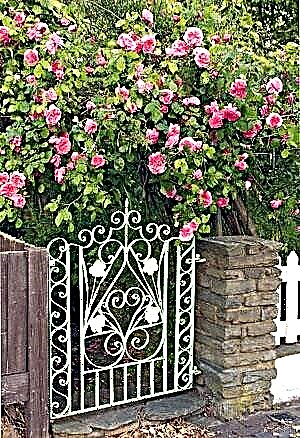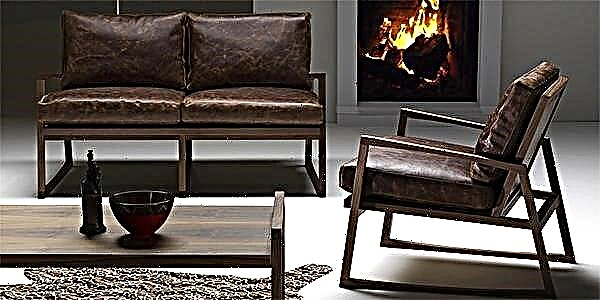Creating a beautiful flowerbed on the site is a whole art. Here you need to provide for a lot of nuances, from the selection of a suitable place to the organization of the original fence. Combining interesting shapes, plants and materials, you can realize intricate patterns and drawings, emphasize the style of landscape design and fill the garden with bright colors.
Features of creating flower beds
Creating a flower garden on a summer cottage from the side seems quite uncomplicated. In fact, in order for the flowerbed to really please the eye with its decorative effect, and the plants in it take root well, you need to know a lot of subtleties. In particular, it is right to choose a place, flower crops, determine the type of flowerbed, and, accordingly, beautifully arrange the fence.
Neighborhood and color selection
In order for the flower bed to look harmonious on the site, it is important to choose the right plants. Shades of colors are selected at their discretion, but observing the general concept of landscape design: these can be plants that will combine in a color palette or, conversely, create contrasting transitions.
Perennials will be the best choice for the basis of the composition, and annual plants will serve as the background, which, if desired, can be changed in a year. Flowers can be planted arbitrarily in groups or according to a specific pattern. In the second case, you must first draw a picture on paper, having thought over the colors and shades, and then transfer the pattern to the flowerbed.
It is important to take into account the requirements of plants for lighting, moisture and soil composition - they must match. There are crops that prefer acidic soils, such as conifers. Only plants with identical preferences can be planted next to them: hydrangea, azalea, frankincense, May lily of the valley and other species.
Plot plan
The design of a particular type of flower bed begins with determining the site for it, which largely depends on the size of the house territory, the location of buildings and functional areas. In front of the house, rectangular group plantings, tapeworms will look beautiful, along the paths you can create border flower beds.
In open, spacious areas, mixborders or rockeries are more often decorated. A remote corner of the courtyard can be decorated with a strict, but no less charming regular flowerbed. If the land area in the country is very small, the best solution would be to design vertical, multi-tiered and raised beds, which will save square meters, but will look no less impressive.
It is a completely different matter when a private house territory is large. Here various options are possible: flower beds with ponds, extensive mixborders, compositions with coniferous plants - all this can be placed if the site is properly planned. If there is a relief with slopes, you can arrange an alpine hill or a terraced flowerbed.
Possible mistakes
It is often difficult for beginner gardeners to approach the design of a flowerbed right the first time.
The most common errors are:
- placement of exclusively perennial plants on the flowerbed. Of course, planting perennials simplifies the maintenance of the flower garden, but you need to take into account that these plants will grow over time and after 5 years they will already be crowded. It is better to fill the gaps with annual plants, the amount of which can be regulated annually. In this case, it is possible to introduce new colors,
- planting one flowering period. In this case, the flower bed will delight the flowering for long. It is better to choose crops with different periods of bud blooming, then the decorativeness of the flower garden will be preserved from spring to late autumn,
- close planting with a lush crown. When placing a seedling on a flower bed, you need to consider how much it grows in adulthood. It happens that branched plants are planted too tightly, over time they begin to interfere with each other and may even die.
DIY flowerbed creation
If you are interested in the question of how to create a flowerbed with your own hands, then you already have a place under the flower garden. Now you need to decide what kind of fencing will be used and how to prepare a soil pillow for planting plants.
The first step is to completely clear the area of debris, including biological (weeds, fallen leaves). Make the outline of the flowerbed. If it will have a rectangular, square shape, you can use pegs as borders. To draw the borders of a circular flower garden, you can use two sticks connected by a rope of such a length that the radius of the flower bed will be. One stick is inserted into the center, and the other - draw a circle on the ground. The flower garden can have any arbitrary shape at your discretion..
The next step - remove the top of the soil to a thickness of about 15 cm, lay the drainage layer of gravel, chipped brick or any other small stone - it will prevent stagnation of water. Next, you need to fill the soil, the standard composition of which includes two parts of the earth and one part of sand and peat. The composition of the soil may include other components (humus, acidifiers, fertilizers), but it depends on what plants you will plant.
Now you can proceed to design the fence. The simplest option, but at the same time, costly, is to buy a ready-made fence made of metal, plastic, etc. Today, a large assortment is provided in stores, from which you can choose designs for both a straight-line installation and a curved design. The most expensive are forged fences made to order.
If you are a creative person or do not have enough funds to purchase a fence, you can do it yourself, using various materials at hand. For example, gardeners often decorate the borders of flower beds with plastic or glass bottles. To do this, a shallow ditch is excavated around the perimeter of the flower garden, with a height of up to half a bottle, after which a container is placed in a dense row, turned upside down. PVC bottles should be pre-filled with sand or earth so that they do not lose their shape.
As an improvised material for the flower garden fence, you can take twigs and branches from sawn wood. The material must be straight or slightly sinuous, but without appendages. The rods are cleaned, dried, treated with impregnation from insects and fungus, if desired - painted, varnished. To design the fence, they are driven into the ground at a distance of 10-15 cm and braided with branches.
The original fence can be made from porcelain plates by simply sticking them into the ground, DVDs. Even a rusty pipe can turn into a stylish curb. To do this, it must be cut into fragments of the same length, driven in along the perimeter of the flowerbed, filled in 2/3 with any small material (sand, earth), and fill the upper part with pebbles or plant small succulent plants.
A small flower garden can be made from old tires. They are installed, painted, covered with the inner empty part with soil, and plants are planted. Now in landscape design you can come across many unexpected ideas when flower arrangements in the garden with old furniture. For example, an old chest of drawers can be turned into a flowerbed by pulling out its drawers and filling them with soil with plants. On this principle, they use bedside tables, chairs, beds and even plumbing.
Tiers
In this case, we are talking about the design of a flower garden with plants of different heights, which in the landscape will create tiers. Typically, such plantings are organized on round or rectangular flower beds adjacent to the house or fence. Planting crops is carried out in accordance with how the flowerbed is visible: if only on one side, then high cultures are placed in the background, and if on all, then in the center. Plants can be of different types, not only flowers, but also decorative shrubs, conifers. Also allowed monochrome landing of one species, but of different varieties.
Round
Round flower beds look good in spacious areas. They can be filled with plants according to different principles.. If you want to create the appearance of a longline flower garden, you can place large-sized plants in the center of the composition, and closer to the edges - lower-growing crops. Another option is to make a flowerbed in the form of carpet, planting crops of the same size. But even on a large plot, it is not recommended to make an extensive round flowerbed, since it will be inconvenient to care for it. Optimum size when diameter does not exceed 2 m.
Rectangular
The advantage of the rectangular shape of the flowerbed is that it is easy to care for.. Such flower beds are most often placed along buildings and fences. When planting plants, it is important to take into account their size so that small flowers do not appear in the background, where they are completely lost behind the crown of higher lush crops.
Raised
Raised flower beds are easy to care for, as you do not have to bend to the ground to plant plants or weed the soil. They are being erected on a stone basis, which is able to maintain its shape while supporting the weight of soil with flowers.. This is a good option for areas where the soil has high humidity. Many plants do not tolerate waterlogging, so raising a flower bed in height will create favorable conditions for them.
From conifers
Flower beds from conifers have recently gained considerable popularity.. Plants are able to clean the air well, and planting them gives comfort, turning the site into a small corner of the forest kingdom. Mainly for planting, low types of conifers are used: dwarf spruce, pine, medium and low fir, thuja, juniper. You can plant decorative varieties with different colors of the crown, supplement the flowerbed with flowering perennials and bushes.
With a pond
A flower bed with a small pond looks particularly attractive. It can be a natural reservoir or artificial, made on its own and surrounded by beautiful greenery.. Such compositions, supplemented by rocky paths, can often be found in the design of Japanese gardens, rockeries. Near the water, wooden sculptures, clay vessels, natural materials will harmoniously look. To make the pond visible even in the evening, the backlight is installed: lamps mounted in stones, small lanterns on the leg.
Near a small pond you need to plant undersized plantssince the big ones will completely close it. You can plant saxifrage, dwarf iris, fern. Coniferous crops (juniper, dwarf thuja) are a little in the distance. Shrubs with white flowers will give additional illumination to the pond even on a cloudy day.
Regular
The peculiarity of a regular flowerbed is that plants that bloom in one period are placed on it. Wherein crops are planted in compliance with the clarity of forms, symmetry and rigor of the picture. At summer residents, such flower beds are not popular. Basically, they can be found in city parks.
Carpet
This type of flower beds can often be found in the front areas of city parks. is he involves drawing from flowers a simple or intricate pattern. The flower garden can be arranged in a small suburban area. To do this, use undersized plants of the same height so that the picture is even. Florists often use ground cover crops that maintain decorativeness throughout the season. In this case, the patterns are very complex, repeating the drawings of real carpets.
Vertical
Vertical flowerbed - ideal for small areas. This design allows you to arrange a lush flower garden with different plants, without taking up much space. Its design implies the principle of the pyramid: the following lower ones are installed on the large lower tiers, decreasing in width. The shape of the flower bed can be any.
House craftsmen make a simple construction of the boards: knock down several wooden boxes of different sizes and install on top of each other. Old tires laid in a pyramid can also be used. Miniature vertical flower beds are made in the form of shelves fastened in one structure adjacent to the wall of a building or fence.
Border
A flowerbed-border is a flower fence, the standard width of which does not exceed 60 cm. For planting, you can use decorative dwarf shrubs or flowers that combine with each other. Often use longitudinal or transverse symmetry. It is better to arrange flowers in two rows so that there are no gaps.
Mixborder
In landscape design, mixborders occupy a leading position, as they fit into any style. They are created from perennial green and flowering plants, planted in a chaotic manner. It is advisable that the flowerbed contains representatives of flowers whose buds open at different times of the season. Perennial grass varieties and coniferous shrubs that will decorate the mixborder in winter will not interfere here.
Rabatka
Such a flower bed is characterized by a narrow long shape. Permissible width should not exceed 3 m, and the length can be arbitrary. Usually such flowerbeds adorn territories along decorative fences and fences.
There must be strict geometric lines, the number of which depends on the size of the flower garden. In the simplest version, there may be 2 stripes of flowers. In more complex variants, the chessboard placement of plants, the alternation of crops in width, are used.
Rockery
Using the design of the rockery, you can significantly diversify the site, make it unique. The basis of the composition is stones and plants of various sizes. Stone blocks are set arbitrarily. In the center of the flowerbed, tall plants are planted, closer to the edge - undersized. Coniferous crops in the neighborhood with perennials and ground cover will look good here. Powder from gravel or pebble crumbs will complement the picture.
Types of fences
The design of the fence is of no small importance, since it can transform the flower garden at times. In addition, it can perform different functions: not only to indicate the boundaries of the flower garden, but also to separate garden paths, certain areas of the garden. The height and choice of material depends on this. If you need to make a decorative fence flower beds, often set low (up to 10 cm) fences made of plastic, wood, brick. To decorate the garden fence, higher and more durable metal structures up to about 30 cm are suitable. To decorate a raised flower bed, a stone is often used that can withstand the weight of the soil and maintain the shape of the flower garden.
Made of cameos
It is difficult to argue that fences made of stones have the most presentable appearance. In addition, such designs become the best solution for flower beds located on uneven areas. With their help, you can level the height, raise the flower garden to a height. The stones fit perfectly into the design of the rockeries and alpine slides, with their help create terraced flower beds. For the construction, natural (limestone, tuff, sandstone, etc.), rubble and artificial stone, brick, and even paving slabs are most often used.
Of the stones, you can make dry masonry, without using a bonding solution, or fix the building using clay, cement composition. The second option is considered more durable and reliable, it is necessary when laying stones of different sizes, as well as high designs.
Another variety of flower beds made of stone - gabions. Such structures are metal grids, from which two walls are installed, and the space between them is filled with stones. The fence looks stylish and modern, often used for the construction of raised flower beds.
Wooden
Wood is a cozy warm material that looks natural on a garden plot. For plants, it does not carry any danger, since it does not heat up and does not oxidize. In addition, the tree is easy to process, with certain skills you can build the most bizarre designs, decorate them with carvings or paint in the desired color.
The only drawback is the fragility. Subjected to constantly negative external factors such as precipitation, wind gusts, soil moisture, the structure of the material gradually deteriorates. Even when using special impregnation and paint coatings, wood will not last as long as metal or plastic. But on the other hand, flowerbeds have not been designed for decades. After some time, you will want to change the design of the site, so this drawback is not so significant.
Wooden fencing can have different interpretations - it all depends on the concept of landscape design and your imagination. If the garden is decorated in a rustic style, you can install around the flowerbed an unpainted low fence, a stockade or an elementary border made of pegs. Fence, perhaps the most popular type of fence. To make it more original, you can decorate it with carved elements. Today, mosaic laid out of saw cuts, as well as borders from wood chocks, are quite popular.
Plastic
Plastic attracts primarily for its low cost. Moreover, the material has good performance characteristics - it is not subject to the negative influence of weather conditions, does not rust, does not melt at high temperatures. In addition, this material is best suited if you want to make a deep fence that will impede the underground development of roots outside the flower garden. Today on sale there are a lot of design options for plastic fences, among which you can choose designs that imitate wood, stone or brickwork. Such fences are easy to install with your own hands, as often they are already equipped with cast pegs that you just need to stick into the ground.
To design a flowerbed of a non-standard shape, you can purchase a plastic border tape sold in rolls.. It can be a simple smooth version of any color or imitating natural materials. A fine addition to such a fence will be a small stone or wood bark, scattered around the perimeter.
Metal
Metal fences look stylish and have high durability. They are made of iron and cast iron. It can be simple welded structures, for example, from pipes of different sections and diameters. Gracefully forged designs, especially those made on an individual project, when the customer can independently choose the sketch and size of the fence. In the summer, forged fences emphasize the elegance of the flowerbed, serve as a support for climbing plants. In winter, amid snow-covered flower beds, they add amazing beauty to the site.
Iron goes well with other materials. Often it is used together with stone and brick. The disadvantage of the design can be called its susceptibility to the negative effects of moisture, as a result of which the design may rust. To prevent this from happening, you need to periodically (every two years) treat it with an anti-corrosion compound and paint.
Concrete
The main plus of concrete structures is strength. The material is not subject to aging and deformation, unless, of course, the technology of its production is fully sustained. Concrete structures will not allow the soil to crumble, strengthen the flower garden. You can purchase a molded garden curb, which consists of individual small blocks with a pointed base. Fragments are easy to install by hammering into the ground with a rubber mallet.
Not only fences for lush flower beds can be made of concrete, but also, actually, mini-beds in the form of bowls, barrels and other shapes, which are then installed along garden paths or decorate the main entrance to the site.
The design of the flowerbed on the site is a very entertaining process, which allows you to significantly transform the landscape design using your own imagination. Adhere to the tips given in the article, so that the desired lush flower garden is in complete harmony with the surrounding territory and delighted with its decorativeness for a long time.
Features
A mixborder is a type of flowerbed that has an elongated shape that extends in the direction of the paths. In this case, the flowers are selected depending on their height (from small to high), the selection is carried out taking into account the timing of flowering. This allows the flowerbed to look luxurious all year long.
Another type of flower garden is called a stall, such flower beds have a certain shape (more often they are square or rectangular). They are located in the center of the garden, planted in the form of a specific pattern. Rabatka is a strip that borders the garden paths (usually they plant low flowers, creating beautiful ornaments).
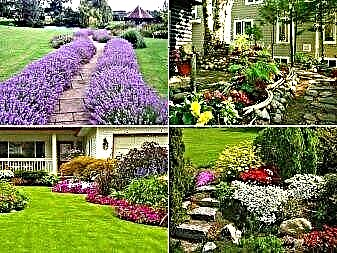
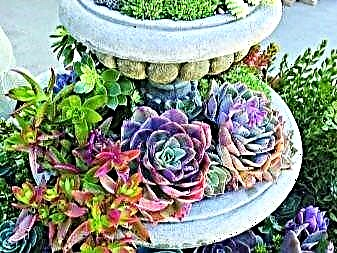
The formation of flower beds involves a competent selection of plants, designing a flower garden from the fence to the house. Different varieties of plants have different flowering periods, the difference between flowering can be from two or three weeks, this is significant. When choosing flowers for a flower bed, it is important to consider the timing in which they bloom. This is necessary so that plants, blooming, can replace already flowering (so flower beds will not be empty).
When planning flower beds, you need to consider their future review. For example, some flower beds will look equally beautiful from any point of view (circular flower beds).

Flower beds with a flat look look beautiful only from the hills. They are best used in the presence of terraces and slopes on the site. If the flowerbed is vertical, it expands the space; if vertical, it narrows.
How to do it yourself?
To create a beautiful and luxurious flowerbed at your cottage you need to adhere to some rules. To begin with:
- read scientific literature, various articles in magazines,
- to study online resources with information on creating flower beds on the site,
- Visit online gardener forums.
It is important to consider your desires and opportunities. It is better to choose flowers that will delight, to approach the existing microclimate of the region.
It is necessary to take into account the budget, calculating how much money you need to spend in order to purchase everything you need to create a flower bed. You can reduce costs if you grow some plants from seeds yourself. It will take some time.
Next, you need to decide what to fence the flower garden with. You can use stones, trees, earthen ditches or artificial material (for example, plastic or concrete fences). After that, it is necessary to begin preparing the soil for planting plants by applying fertilizers. You can draw an approximate plan for planting flowers, determine the number of plants that will grow on the flower bed. It is worth adding a sketch with a description: so the picture of the future flower garden will be more understandable.

After that, you should arrange the flowers in pots on the proposed place of the flower garden: this will allow you to see how they will be combined with each other. Having determined the location of the flowers, you should plant them, water them, and mulch the earth at a distance of 10 or 15 centimeters from the plant. After transplanting, plants need constant care, they must be regularly watered, shaded in the heat. Any flower garden will feel great in sunny space if there is good soil with fertilizer.
When creating the first flower garden, it is better to choose flowers that do not require special care. First you need to gain experience. After that, you can choose more fanciful plants, creating luxurious home gardens.
For example, a flowerbed of several tiers framed with stones will look beautiful. You can do it with the help of common plants. This flower garden looks luxurious.
Composing different compositions, you can experiment, select different types of plants.
Choose plants
Any gardener wants a flower garden to be a luxurious decoration on a garden plot. The flower bed will charm guests or family members, if you choose the right unpretentious plants suitable for the climatic conditions of the area. These colors can be peony and clematis. They can grow for many decades without changing their place.
If you choose beautiful, but whimsical plants, they may not endure the harsh winter. You can give preference to southern plants. Not every shrub can survive the winter. It is worth immediately paying attention to this fact. The choice of plants that are suitable for the climate of the area has many advantages in the design of the flower garden. Such plants are easier to care for, there is no need to cover them in the winter. No need to be afraid of pests (moles, mice), as well as diseases.


This will significantly reduce costs, there will be no need to buy new plants, replacing the dead, there will be no labor costs. So the flowerbed in the winter season can look beautiful. Planting unpretentious plants will allow you to find time to relax and enjoy the beauty.
For decoration, it is better to give preference to perennial flowers. Their main advantage is that they will delight and decorate a personal plot for many years. There is a minus - not all perennial plants bloom immediately after planting, although over time they will not require special care. If you want flowers to bloom when the first sun rays appear, you need to choose plants with bulbs. Bulbous plants begin to bloom early, decorating the flower garden with an abundance of flowers of different shades and shapes.
Among these colors, hyacinth can be noted. In March, the spelling begins to bloom, after it crocus, then they are replaced by a daffodil and a tulip. A flower bed with such flowers can be made round in shape, fencing plants with stones or a tree. The flower garden with primrose combines beautifully with violet. Rose looks gorgeous with phlox. When creating flower beds with annual flowers, you can constantly change the palette and shades, choosing something new every year. It all depends on the gardener's imagination.
Fine annual plants are marigolds, petunias, dahlias and balsamines. These spring flowers are undemanding, they feel great with ordinary care. They can be planted near the house.
Landing patterns
Modern floral arrangements adorn almost every household plot. It is the flowers that will allow you to enjoy the beauty of nature in the warm season. Even an amateur gardener can create a beautiful flower garden. For this, it is necessary to study the possible planting patterns.
First you need to improve the very territory of the cottage. It is necessary to take into account the conditions of favorable plant growth. This will reduce possible errors in the formation of the flower garden. It is necessary to determine the shape and size of the flower garden, choose its main palette.


It is better to start with the design of flower beds with perennials. They are unpretentious, do not require complicated care. Do not clutter the flower garden with plants. Their excessive amount will adversely affect flowering, and the flower bed will lose its attractiveness. You should not plant flowers one by one: a group of flowers looks prettier than one flower separately. Flower gardens look luxurious with an abundance of flowers from the beginning of spring to the very end of autumn.
Choosing the scheme of perennial plants, you need to take into account the period of their flowering. Annual flowers easily fill the gap between flowering. It is necessary to choose a scheme, taking into account the indicators of mail and the presence of light. Each flower bed should contain plants that are similar in care. You need to responsibly approach the choice of colors for the flower garden. It should not be variegated, it is better to combine bright plants with flowers of calm tones.
If you take into account all the nuances, making up a planting scheme, the flowerbed will look luxurious.
Gradually, you can create more complex compositions, designing different patterns. An ideal bed would be that looks equally beautiful from either side of the garden. Many levels are most often done near walls, fences. Choosing a scheme, you need to take into account the shadow and solar participants of the cottage. Due to this, you can choose the right plants for the flowerbed, providing them with comfortable conditions.
It is necessary to correctly calculate the required number of plants. To do this, the entire layout of the flowerbed is divided into conditional square zones of about one meter on each side. It is necessary to calculate how much each species of plants will occupy. All data must be divided by the average indicator, standard for planting. For example, 2 or 3 large plants, 4 to 6 medium, 7 to 9 plants below the average size and 16 to 20 small plants are planted on a flower bed up to 1.2 meters in size.
To correctly transfer the scheme from the drawing to the site, it is necessary to note the contours with the help of sawdust, chalk or sand. Next, you need to dig up the earth, remove the weeds and sprinkle the soil with special soil. You can make changes to the scheme. Making out a flower garden, it is necessary to take into account the acidity of the soil: basically plants are demanding, they need certain conditions.
Medium-sized plants perfectly complement any floral arrangement. These include peony, daylily, lily, iris, bell and phlox. To close empty spaces, you can plant an aster, petunia, laureate or salvia. Lupins, aconites or delphiniums are ideal for background decoration. Shady parts of the plot can be decorated with anemone, fern, geranium. If the soil is acidic, hydrangea and fern will feel fine on it.
The combination matters. It goes well with rose, virginia, sedum, balsam. A beautiful combination will be a palette of pink, orange and red tones, diluted with purple. Adhering to these tips, you can easily arrange an amazingly beautiful flower garden on your site.

Flower garden shapes
Design options for flower beds may be different. An original solution would be to use old car tires. Such flower beds are common. You can paint the tire in the desired color and add decorative elements. The result is a beautiful flowerbed with flowers. From tires, you can make a multi-level flowerbed, while you need to choose tires that differ in size. So you can arrange any flower garden.
An old tree stump is also suitable for a flowerbed, it can be an excellent flower garden. Using unnecessary furniture can be a great idea. But such flower beds for the winter season are better to bring into the house. If you want to make a flower bed out of concrete, it won’t take much time. Such a flower garden will look beautiful and appropriate.

The location and shape of the flower garden directly affects the selection of flower sizes. A planting of plants with a rabbit is made out in flowers of one height from 15 to 40 cm. A round flowerbed is made out, starting from the center with tall plants, ending with low ones at the outer circle. A flowerbed in the form of a mixborder is usually created near the walls or fence, they begin with tall plants with a smooth transition to low flowers.
For the competent design of the flower bed, you must correctly select the planting scheme, choose a zone for a certain type of plant. This will improve the entire flower garden. Before dividing the infield into flower beds you need to think about whether they will fit into the design of the garden, whether they fit the style. For example, a border with flowers beautifully frames the paths of the garden; low plants are better for it.
A small pond in the center of the flower garden will look luxurious. Most of all, this design is suitable for a large plot.
A fashionable direction is a flower bed mixborder. This is a free-form flowerbed. It is most often used in the design of country houses. No less popular are flower beds of a vertical form. Begonia and petunia are used for them.
Decor
Choosing landscape decor for a flowerbed on a personal plot, you can follow fashion trends or apply non-standard solutions. Now the landscape design allows you to carry out any idea of the gardener to create a luxurious flower bed. The main thing is the simplicity and harmony of decorative elements. This concept can be implemented by various methods with perennials and annual plants.
The first type of decor is monochrome, it uses the same gamut of colors. For example, a combination of various shades of green is possible. You can use a combination of green and white (hydrangeas, primrose, stalks, hosts, astilbe).
A flower bed of plants looks beautiful in green and pink using roses, peonies, clematis, heicher, chrysanthemums. The combination with red looks amazing (maples with red leaves, decorative barberry and geyhera).
The second type of decor is monoform, it uses flowers of the same shape. The combination of flowers with a rounded crown shape looks great (round spirea, large-leaved hydrangea, rose, spherical willow and thuja). The third type of decor is contrast. It uses plants of bright colors. Blue and yellow tones are appropriate here (iris, viola, marigolds, nasturtium, yellow daylily). Original and a combination of a pink shade with blue (rose, lavender, verbena, matthiola bicorn). Vertical flower beds look luxurious. Such a planting can decorate any garden.
The main requirement for landscape design is the decoration and decoration of flower beds. Absolutely every flowerbed can be transformed by adding decor. It is easy to do it yourself. It is worth decorating the central flowerbed, as it is the basis of the entire flower arrangement of the garden.
On the central flowerbed, the decor element will be viewed from any direction. The basis of such a composition may be:
- mosaic ball
- a drinking bowl for birds,
- wooden cart
- snag,
- log,
- stump,
- wheel,
- sundial,
- sculpture,
- mirror,
- arch,
- plant with dense foliage.

Any of the key design elements should be single. In addition to the center element, fencing is important, as well as decorating the soil around the plants with multi-colored gravel. If you use colored gravel, you can emphasize the shape of the flowerbed, beautifully decorate bright plants. The decor of the flowerbed should combine beautiful and useful.
It is now fashionable to combine flowers and edible plants: this is how they create a decorative garden bed. To create a decorative bed, it needs to be made raised from bars, large boards. After you need to overlay it with stone slabs. Next, lay the soil, in rows or beautiful patterns plant flowers, garden plants. A combination of different varieties of salad will be excellent, you can use green, red, lemon color with purple and green basil, different types of cabbage.

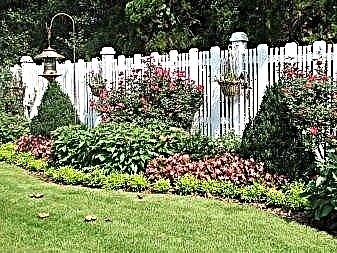
It will be interesting to look at a flower bed in which all empty places are filled with radishes or dill.
Tips of summer residents
Cottage is a place where not only edible plants are planted. Many people want to create beautiful compositions of flowers so that they please during their stay at the cottage. You can decorate your garden with flower beds, stone and wooden slides. Any beautifully decorated garden will please the summer residents themselves, their neighbors and guests. Create a beautiful flowerbed under the power of any gardener. You do not need to attract professionals for this. To do this, adhere to certain tips.
After planting the seeds, they need constant care: due to this, sprouts will appear, plants will grow, and then bloom. It is necessary to consider the design, style, fencing of the flower garden. This is necessary to create a holistic composition that fits perfectly and organically into the design of the infield. All floral arrangements should be combined with each other.


Summer residents are advised to use the flowerbed functionally, decorating it with flowers of different heights. In this case, it is important to remove annuals that have faded from the flower garden. This can spoil the appearance of the flower picture.
If the design of the infield is focused on natural materials, you can cover the flowerbed with stones, painting them with different colors, for example, under insects. So it will attract attention even more, while not overloading the flower garden. If tires are taken as the basis, painting will allow them to give an integral composition. For greater harmony, you need to plant flowers in the form of color spots: this way they look especially beautiful. It is important to consider the main color of the flowerbed: it should not merge with the shades of flowering plants.
In order for the flower bed to remain beautiful, plants must be periodically trimmed and fed. It is necessary to decide in advance what the arrangement of the flower garden will be. Usually use unnecessary furniture, building materials, what lies in the country without work.
Types of decorative flower beds
There are a huge variety of shapes and patterns of flower beds. Each species has its own differences, features of creation and care. To date, the following options for designing flower beds in the country are distinguished:
- Flower border.
- Rabatka.
- Mixborder
- Alpine hill.
- Tapeworm.
- Vertical flowerbed.
- Cascading flower beds.
- Hanging flower beds.
- Arabesque is an original novelty in the world of landscape design.
Each of the presented options is characterized by certain conditions for planting flowers, decorative design, care requirements and the color scheme of the composition.
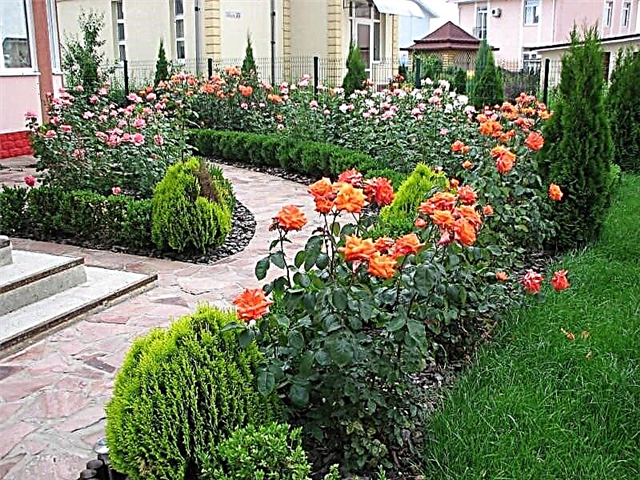
The basic principles of landscape design of the local area
In order to understand how to design flower beds near the house, you need to understand the basics of landscape design. Landscaping is the art of organizing space with the help of natural elements - plants, stones, trees. This direction is subject to the basic artistic principles of harmony.

The choice of plants for a flower garden in front of the house must be done taking into account climatic conditions and soil features
- Integrity.
- Balance.
- Proportionality of forms.
- A color scheme.
Integrity implies the unity of all elements on the site. All of them should be made in one style and create a single composition. It can be the same elements in different parts of the plot or the unity of color in decorative compositions. To achieve integrity, you must immediately choose the landscape style and create a general plan. This is especially important for the entrance group, that is, the elements placed in front of the house. Since this part of the space creates a general impression.
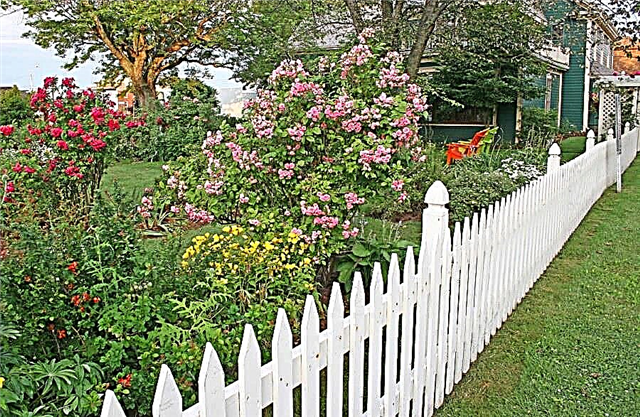
In a sunny place, roses, Japanese quince, chokeberry or hazel are planted. From grassy plants in the sun, bells, daisies and marigolds grow well
Balance implies an even distribution of elements in the composition. In the flower garden in front of the house, it can be patterns of flowers, borders along the edges of the flowerbed and paths. Balance can be symmetric and asymmetric:
- Symmetric balance involves repeating the shapes in a mirror image relative to the center line or point. Such a center can be a house, a central walkway, a flower bed in front of the house.
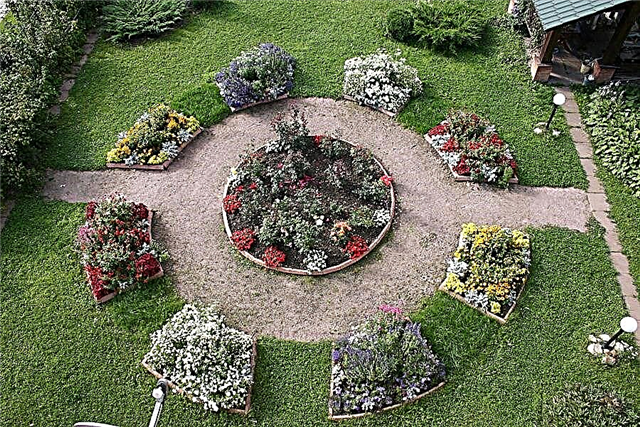
The track from the gate to the porch of the house is often chosen as the center line of the composition.

A well-arranged flower garden will adequately adorn the front part of the infield
Harmonies in an asymmetric balance are more difficult to achieve, but the asymmetry looks more natural and picturesque.
Proportionality of forms. Flowerbeds, borders, artificial decorations, boulders should not prevail over each other and create a crushing impression. The smooth transition from one element to another is important. The transition from larger to smaller forms creates a natural perspective.

When compiling a flower garden, the harmony of shapes, colors and plant height is important
To combine colors, you can choose decorative plants of the same color scheme or contrasting with each other. How to arrange flower beds near the house - there can be many color schemes. For example, the curbs of the tracks are made of white flowers, and the design of the flower garden in front of the house is made of blue and blue. Stylishly look compositions in which plants of the same color are selected - red or purple. White flowers easily set off any contrast. The main thing is not to plant different plants of different colors and sizes all together.

Tall plants attract attention and determine the structure of the flower garden

Lower plants fill the flowerbed and serve as a backdrop to the composition.
From the basic art rules follow additional principles of landscape design:
- Naturalness.
- Verticality.
- Plant combination
Naturalness. One of the principles of landscape design is the enjoyment of nature. Therefore, to achieve naturalness, one should not get carried away with artificial elements - fences, statues, as well as straight lines and strict geometric patterns. It is better to complete the framing of figures from a grass or flower border, the boundaries of the elements are indicated with natural stones or boulders.
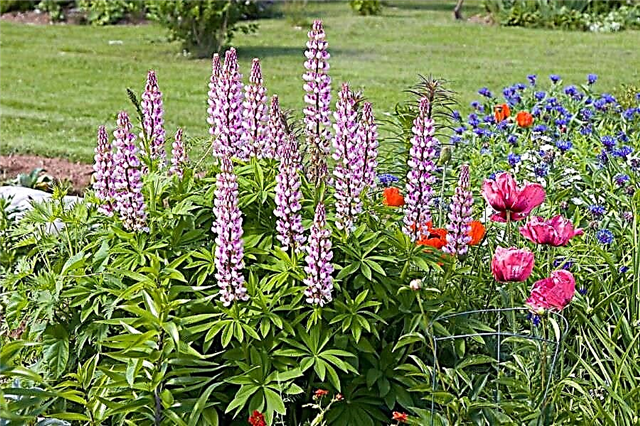
Naturalness involves the use of unpretentious herbaceous plants - lupins, peonies, phlox or daylilies

As a living border for a flower bed, the easiest way to use a geyher, tenant or arabis
Verticality. A new trend in the design of territories. It involves the development of ensembles not only in the horizontal, but also in the vertical plane. This may be the design of a flower garden in front of the house with vertical plants or in the style of an alpine hill. The creation of hills and elevations increases the area and provides additional opportunities for planting plants.

Amur grapes are an excellent choice for vertical landscaping of a site located on the east or west side of the house - a powerful vine that grows quickly up to 8 meters long
The combination of plants implies not only beauty, but their biological harmony. It is important that the plants are combined according to their natural requirements: to light, watering, soil acidity. Before you break the flower garden on the site, you need to find out how much space the plants occupy in adulthood.

A flower bed on the north side of the house is made out using shade-tolerant plants - juniper, western thuja, microbiota, frankincense and hosts

A variety of photophilous shrubs and flowers are suitable for a flower bed on the south side of the house
Flower border
The design of flower beds and flower beds in the form of a border is an excellent solution for cottages where there is a shortage of free space. To create a flowerbed-border, the master needs:
- Along the track, preferably on both sides, clear a piece of free ground with a minimum width of about 25-35 cm.
- Soil must be removed, drainage laid (sand or expanded clay), fertilized soil mixed with peat backfill.
- After moistening the soil, you can plant flowers.

For flower borders, preference is given to low-growing plant varieties, the inflorescences of which are lush balls or bunches.

This version of the flower garden stylishly emphasizes the interior of the garden plot, giving it a “lively” original look.
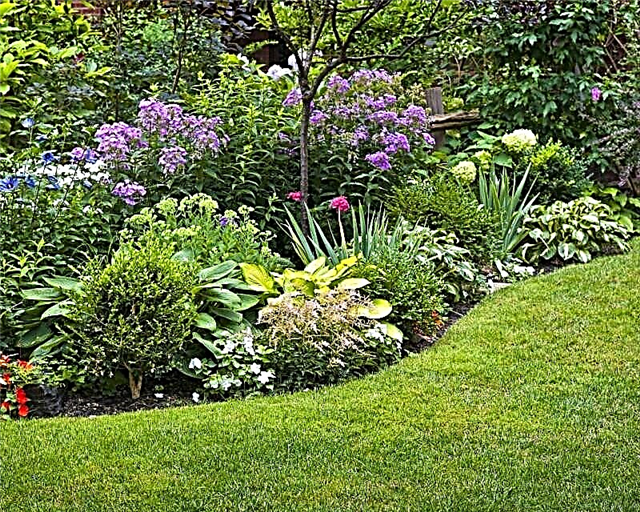
Mixborder Palisade
To create such a flower garden, you also need a rectangular soil section, but the principle of planting is strikingly different.

The manufacturing technology provides for the creation of rows: on the rear edge of the flower garden, higher flowers are placed, and closer to the front flank, the lowest representatives are planted.

Sometimes, for convenience, craftsmen have small borders between tiers-rows, which allow more accurately determine the boundaries of flower rows.
Alpine hill
Making an alpine hill is not an easy task. An important condition for its creation is the laying of large enough boulders or stones to form artificial ledges.

In the process, you may need the following actions from a landscape designer:
- Preparation of the skeleton - stones or boulders are laid out on the ground, sometimes replaced with old glass bottles. The free spaces between the frame elements are filled with soil.
- On the soil and protruding stones, “paths” are made of fine gravel or gravel.
- The main plants that plant such slides are small coniferous shrubs, saxifrages, stonecrops or flower arrangements that are unpretentious in maintenance.

A flower garden of this type is distinguished by its original appearance, specific asymmetric shapes and fairly minimal care requirements.
Tapeworm
The main feature of such a palisade is the design of a floral composition from one species of plants, as well as the creation of a single color shade on a flower bed.

A decorative fence or shape does not matter, only the wishes of the owner of the garden plot and the master are taken into account here.
Interesting solutions are creating edging from small stones, painted glass bottles or a flowerpot from wooden slats.

Cascading flower beds
Creating cascades is a very original idea among irregular flower beds. For work, it is necessary to make frames for cascades: most often in this role are wooden or metal boxes.

On the bottom of such containers make several holes for the outflow of water, lay a drainage pillow of sand and expanded clay, fill the soil.

The boxes are stacked on top of each other in a staggered manner so that more than 2/3 of the volume of the container remains free for planting flowers.

The landing proceed after the formation of the frame. For cascading flower beds, it is preferable to use the planting of low-growing plants.

Hanging flower beds
It is easy to make such flower beds yourself from improvised materials: old plastic bottles, small wooden containers, old metal utensils can be used as hanging flower pots. The main tasks of the wizard:
- Make a drainage system for the outflow of water.
- Decorate hanging planters.
- To think over fastening: it can be a strong grid or a chain on which a home-made planter is hung.

In addition, there are often options for attaching a miniature hanging flower bed to a fence or wall of a house.
Arabesque
The flowerbed butterfly is a fairly new, but popular trend in landscape design. The main idea in creating such a flower garden is the design of the original decorative bridge between the two halves of the palisade. For work, preliminary creation of the scheme, marking the plot, step-by-step planting of flower compositions and the manufacture of a border or border are necessary.

Principles of flower garden formation
When making a flowerbed at the cottage with your own hands, it is imperative to follow the following principles:
- Preliminary creation of the scheme on paper. The drawing thinks over the design options for the flower garden, drawing, the composition of the flower arrangement.
- Land marking. This step is mandatory if you plan to produce a complex composition.
- Strictly step-by-step work on creating a flower garden.
- You should not load the palisade with an excess of plants - they will require more careful care.In addition, flowers can compete with each other for fertilizer and moisture, which will lead to the rapid withering of some types of flowers.
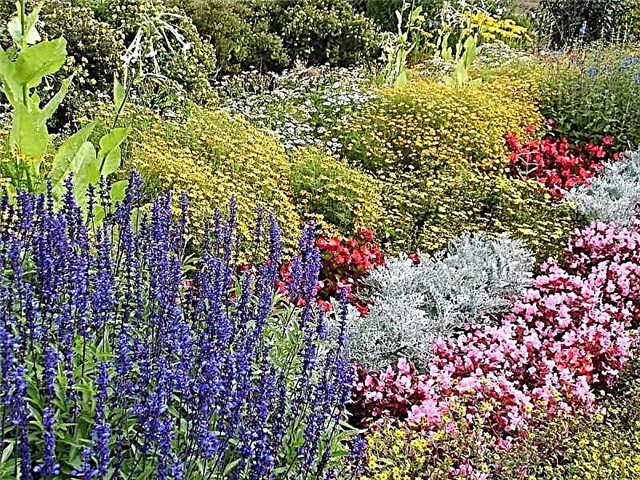
The most important thing for a beginning gardener is to remember that it is better to train on miniature flower beds with unpretentious plants.

Accounting for the flowering period
Consideration of this factor is strictly required for large flower beds with a complex floral arrangement. Further actions of the landscape designer depend on the choice of flowerbed: continuous or sequential flowering.

To avoid possible errors in the formation of the palisade, you should carefully study the properties and periods of active flowering of each representative for the composition.

Original ideas for flower beds
Using the classic options for flower beds is desirable, but not necessary. A creative approach to the work can contribute to the emergence of new interesting ideas that differ in the original pattern, bright colors, elegant framing of the flower garden.

Flowerbed spiral of stones
The complex base structure is composed of a strong metal mesh in two layers, between which a natural stone is placed.

The mesh frame is formed in the form of an ascending spiral, and the free space is filled with fertilized soil. Coniferous crops and saxifrages are preferred.
Flowerbed options: how to decorate
How to properly break a flower bed so that it pleases the eye, there are many options for forms and their combinations. Each of them one way or another changes the space.

The assortment of plants for flower beds should provide continuous flowering throughout the season
Classical forms of beds:
- Round carpet.
- Arabesque.
- Vertical construction.
- Rockeries.
- Mixborders.
Round flowerbed
A round carpet bed under the window opens the space and visually expands it. It is well suited for a small area, creating the illusion of space. Various color combinations and patterns of low colors look beautiful here. The composition can be diluted with decorative herbs or moss. It is better to frame such a design with a border of flowers or decorative stones. The same border can be planted along the tracks, which will create the dynamics of the ensemble.
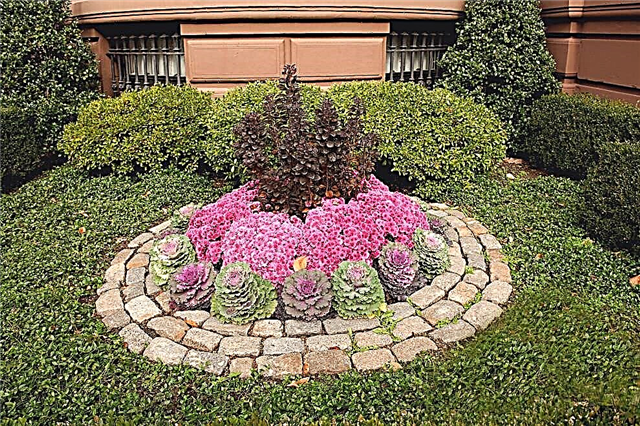
A round flowerbed looks beautiful with a dominant plant in the middle and low flowers planted in a circle

The simplest option is a round monoclomb filled with flowers of the same type.
Flowerbed and flower garden, what is the difference
There is some difference between a flower bed and a flower garden. A flower garden can be called any piece of land on which decorative vegetation is planted in any order. They may include many annuals, deciduous shrubs and conifers.

A flower bed is called a flower bed of a regular geometric shape, in the design of which mainly annual crops and grassy perennials are used. Plants in the flowerbed are planted in a certain sequence in compliance with symmetry.

Usually a flower bed has a closed loop. It is surrounded by garden paths, paving or embedded in a green lawn. A narrow flower border is created around the perimeter from undersized annuals or ground cover species of perennials.

As an exception, flower beds are sometimes arranged, one side of which borders a fence or a wall of a house. But in this case it should not be confused with a mixborder, the principle of which is somewhat different.

Interesting. The flower bed can be called a variety of flower garden. But the flower garden is not always a flower bed. This is a broader concept, including alpine hills, rockeries, mixborders and other floral arrangements.
Types of beds: regular
According to the method of planting, flower beds are regular and irregular. Regular ones are more time-consuming in the device: plants of approximately the same height, necessarily undersized annuals and ground cover perennials are selected for them. It is important to choose all types so that their flowering coincides. The main feature of regular flower beds is the sharpness of the lines forming a beautiful geometric ornament.

Regular flower beds are rarely created on personal territory, their prerogative is city parks and squares. This type of flower garden requires constant care, the complexity of which is that the root system of perennials grows rapidly, knocking down the picture. But, if there is time and desire to create something special near a private house, you can try.

First, an ornament of the future flowerbed is drawn on a sheet of paper, on which different types of plants are indicated by color. Then the drawing is transferred to the site with the prepared soil: with the help of sand, lines of the pattern are drawn. And only after that in a strictly defined order (in accordance with the plan) plants are planted.

Tip. If it is decided to make a flowerbed of a regular type on the site, you can use vegetation with foliage of different colors in its design: spotted cassock, creeping clover, trapezoidal acid, blood-red geyhera, various varieties of survivors and saxifrage.
Types of beds: irregular
In the country, the easiest way to make an irregular flowerbed, which is characterized by more free execution. Flowers in it are arranged in rows or dots, several plants in a group. To prevent bald spots in the flower garden, decorative grasses and grains are sown between large species.

Soil preparation

Since the autumn, preparation of the site for spring planting of seedlings begins. First, the type of soil is determined and, if necessary, its improvement is carried out. For each type of soil, different additives are used that are evenly distributed on the surface of the future flower garden, and then deep digging is carried out.
How to make the soil better:
- Clay soil. The heaviest type of soil, and to increase its fertility is the most difficult. Ideally, you need to remove the top layer of 30 cm, and replace it with black soil. Since not everyone can perform this labor-intensive work, it is possible to do differently: bring sand, peat and humus and mix it with the earth on the site by digging,
- Sandy ground mixes with imported chernozem,
- Loam improved by the addition of humus and sand.
It is recommended to dig a site in the fall, when the first rains pass, and the earth softens under the influence of moisture. But you should not do this immediately after rains, so that the soil does not stick to the shovel and shoes. During digging, the remaining weed roots and stones are selected from the soil.
Important. Immediately after digging, the earth is in a loose state, and then, under the influence of rains, it compacts and settles. Therefore, initially the site should be about 15 cm higher than the lawn. In this case, after shrinkage, the flower garden will not be lower than the soil level.
Plant selection and planting

The classic round flower bed is made up of several types of plants that vary in color and habit. The tallest flowers are planted in the central part, and their height gradually decreases as they approach the edge. Flowering periods are also taken into account. The bulk are annuals that bloom all summer, and between them are perennial plants, which for the most part do not differ in the duration of flowering.
What flowers to use in the flowerbed:
- Tall.Cannes, delphiniums, digitalis purpurea, lupins, rudbeckia "Golden balls", echinacea, irises,
 Rudbeckia Medium height.Gaylardia, Chinese aster, celosia, zinnia, erect tagetes, lavater, antirrinum, mirabilis, allium, garden tradescantia,
Rudbeckia Medium height.Gaylardia, Chinese aster, celosia, zinnia, erect tagetes, lavater, antirrinum, mirabilis, allium, garden tradescantia,
 Zinnias in the garden Undersized.Petunia, lobelia, gazania, oxalis, clove grass, anemone, scabiosis, awl-shaped phlox and primrose,
Zinnias in the garden Undersized.Petunia, lobelia, gazania, oxalis, clove grass, anemone, scabiosis, awl-shaped phlox and primrose,
 Clove grass Ground cover, or bordering. Purslane, seaside cineraria, viola, daisies, sheath, rezucha, muscari.
Clove grass Ground cover, or bordering. Purslane, seaside cineraria, viola, daisies, sheath, rezucha, muscari.
 Aubriet at the flowerbed
Aubriet at the flowerbed
Seedlings of flowers are planted in May, when perennials appear from the soil.

This makes it possible to determine where and at what distance from rhizome plants to plant annual species. When exclusively annual plants are used in the flowerbed, they can be sown with seeds in parallel grooves. But in this case, the development of plants will require more time. Consequently, the flowerbed will bloom much later.
Important. Different plants do not react equally to moisture or dry soil and its composition. In order for all plantations to feel comfortable, you should choose vegetation with the same needs for agricultural technology and the type of soil.
Flowerbed care
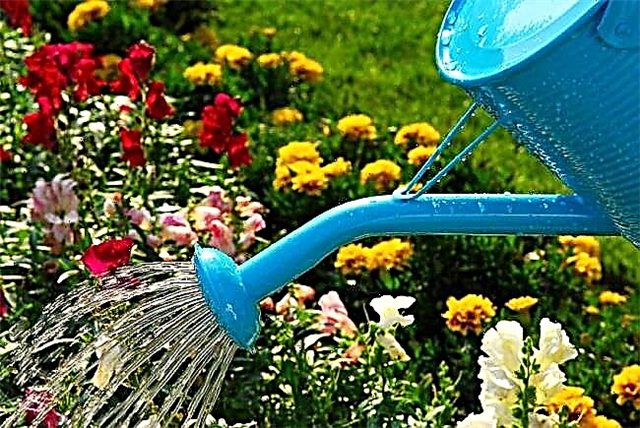
The main care for the irregular type of flower garden is carried out immediately after planting seedlings and before rooting the plants. At this time, it is important to irrigate with subsequent loosening so that a dense crust does not form on the surface of the soil. When the plants get stronger, the flower bed is weeded and watered as necessary.
Top dressing is carried out during the budding period of plants. Complex fertilizer dissolves in water and is applied during irrigation under the root or through a sprinkler. The sprinkling method is more effective because the plants receive nutrition through the root system and directly through the leaves. In autumn, when the remains of the vegetation are removed from the flowerbed, humus or compost is introduced into the soil.
It's important to know. From time to time, the summer flower garden is inspected, and wilted flowers are cut. This measure promotes the growth of buds and more magnificent flowering.
Flowerbed Tips
True, experience comes with time. But I don’t feel like learning from my mistakes. To make the design of the first flowerbed in life go more smoothly, it is better to listen to the advice of experienced flower growers.
Tips for beginners:
- It’s better to make several small flower beds than one large one, because a small flower garden is easier to care for,

- In a flower garden that is too long, it’s difficult to look at distant details,
- The diameter of a medium-sized circular flowerbed is about 2 m,

- The round flower garden looks more spectacular when its central part is slightly raised,

- If the flowerbed is made on the lawn, it should not be limited to concrete or any other border. It is better to make a border from low annuals - so it will look more natural.
- So that the lawn grass does not capture the territory of the flower garden, a plastic border tape is dug around its perimeter,

- You should not save by planting plants too densely, as they will stretch and bloom weakly,
- Too thickened landings develop diseases faster.
A few words should be said about the rhizome plants. Their root system is growing rapidly, so every 3-4 years, an update or reconstruction of the flower garden is carried out. In the fall or early spring, overgrown species are dug up, the roots are divided into dividers, and the updated planting material is again planted in place. So that the process is not too tiring and does not take several days, you can divide the most overgrown species every year. It should be noted that some perennials, for example irisesare divided from June (when the flowering period ends) until the end of summer.
Useful video on forming a simple flowerbed:
Floating flower beds

Original look flower islands floating on the mirror of a reservoir. Fertile soil is poured onto a foam sheet with low sides, and seedlings of low annuals are planted in it: petunia, purslane. The island is attached to the anchor (large stone) so that it does not carry to the shore. You can decorate a floating island not only with an artificial pond. If the cottage is located on the shore of a natural reservoir, the islands are arranged along the coastline of the site.
Tip. A floating flower garden does not need to be watered if small through holes are made in the foam, through which moisture will flow to the roots directly from the reservoir.
Vertical flower beds

Flowerpots with flowers are arranged in a stepwise order on a metal frame specially welded for these purposes. The advantage of a vertical flowerbed is that it is easy to care for, since there is no need to fight weeds. Its design uses garden and indoor plants, as well as decorative garden figures. A vertical flowerbed is installed anywhere: on the lawn, near the porch, on paving in the yard.

Tip. Attention should be paid to the fact that potted plants need more frequent watering.
Monoclobes
On a green lawn, monoclobes look beautiful, which are made up of plants of the same species and color.

The downside is the short flowering time. You can compensate for the deficiency by planting several plant species with different flowering periods in turn. For example, first undersized white tulips, then blue lobelia or blue ageratum, and at the end of summer - ruby asters. Thanks to this technique, the country landscape will be updated throughout the season.
Mini flower beds - fantasy is not forbidden
The concept of a flower bed has expanded, and now it is proposed to make it out of any object, the main thing is that soil can be poured into it. Such creative mini-beds look pretty cute and delight with their unusualness.
The most common option is small hanging flower beds. The earth is poured into a linen bag, a leather boot, a rubber boot, or an old mailbox and a plant, preferably an ampoule, is planted here. An impromptu flowerbed is hung on a fence or wall of a house as a decor.

Non-standard flower beds are obtained using furniture. Any unnecessary item prepared for landfill (bed, chair, table, sofa) is put on the lawn, partially covered with soil and planted with flowers. They also come with holey boats, wooden crates, garden cars, wicker baskets, and even cars.

Using old items in creating flower beds is now fashionable. But there is one minus - under the influence of moisture, the fabric and wood are destroyed. To extend the life of the flower bed for several years, the wooden parts are varnished or painted, and plastic bags are put into leather and fabric objects, and only after that the earth is poured inside.






